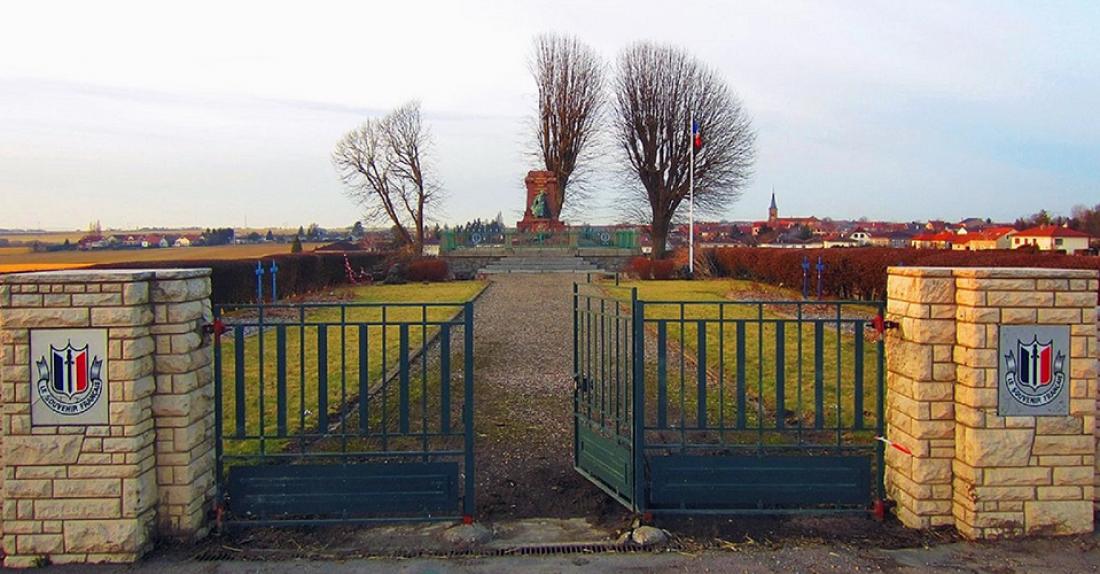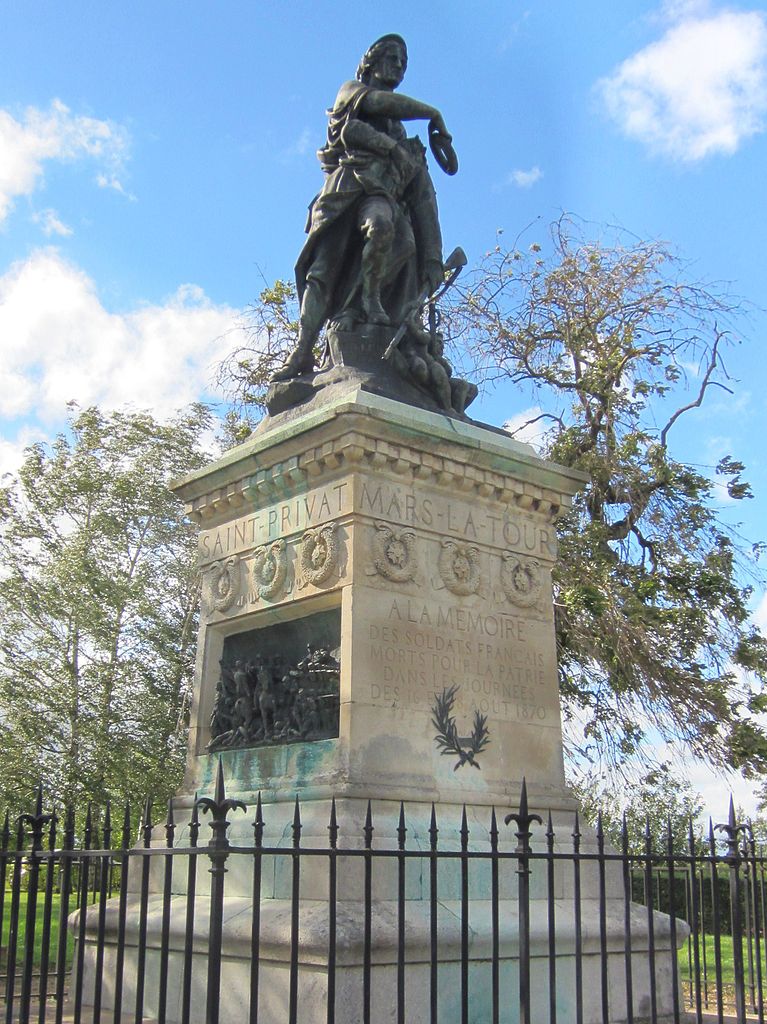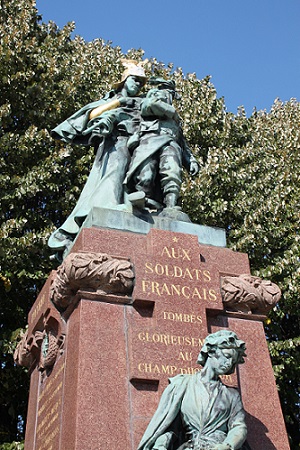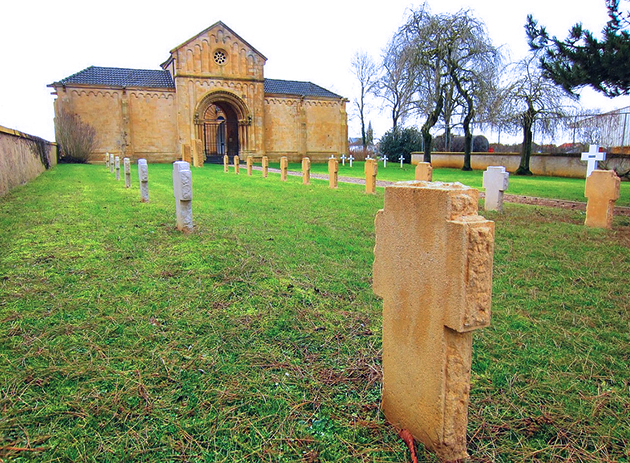The memorial landscapes of the Franco-Prussian War

The idea of the landscape as witness has become important in the complex relationship between history and remembrance. Through its use and appropriation, the landscape, imagined and constructed through the evolution of societies each with their own historical background, acts as a medium for signifying and preserving memory. The various types of early remembrance markers of the Franco-Prussian War tell us as much about the different manifestations of the memory of soldiers killed in battle as they do about postwar remembrance actors. They offer up a picture of the thought communities of the late 19th and early 20th centuries, by projecting particular aesthetics, military marks, assertions of identity and a new interaction with the environment in which they are inserted.
The memorial landscapes of the Franco-Prussian War: a plural concept
The end of the Franco-Prussian War marked a turning-point in the way conflicts were remembered and the beginning of the first remembrance dynamics, which were to become systematised after the First World War. These war memorials (monuments aux morts in French; Kriegerdenkmäler in German) spread across France and Germany, demonstrating an entirely unique artistic creativity, in particular around the new territory of Reichsland Elsass-Lothringen, annexed in 1871. Around Metz, the first remembrance markers of the Franco-Prussian War appeared, physical witnesses of a new symbolism: that of the frontier. The landscape of the surrounding countryside thus became a place of both plural and shared memories between German and French identity.
Landscapes, memories and society

War memorial, Mars-la-Tour, sculpture by Frédéric Bogino. Photo credit: Aimelaime – public domain
When the war was over, these early places of contemplation took on a special significance. The graves punctuated the landscape of the Moselle countryside while also symbolically entering the daily lives of the civilian population. The first major actors of this early remembrance, and charged with preserving it, many civilians soon found themselves maintaining the graves of soldiers they did not know, with some having their land requisitioned for the initial temporary graves, in return for compensation. These early markers, then – hurriedly put in place during the conflict and also in its aftermath, in 1871 – were imposed new elements which used the landscape heavily, and people had to learn to live with them. These first graves often became places of contemplation, or just a means of combating oblivion.
The gradual development of this cult of remembrance in the newly annexed provinces was already one of the key points of the Treaty of Frankfurt, Article 16 of which provided for the mutual respect of both French and German soldiers killed in action, by maintaining the graves of both sides in their respective territories. As early as 1872, it became possible for French and German people alike to monumentalise the memory of their soldiers. These future memorial sites then became part of a visual culture of remembrance through images. The place, forms and visual codes used by the remembrance marker linked memory to identity. Often built in village squares, the French monuments and markers were distinguishable from German remembrance structures, whose design more readily took nature into account: the isolated Denkmäler bore witness to an ongoing quest for harmony between the natural landscape and architecture. Each of these sites was integrated into the landscape, in the sense that they were continually subject to the reactions of the civilian population: one major event for these markers was the campaign against iconography waged by the German Empire after Alsace-Lorraine was returned to France in 1918. Only a handful of sculptures have survived in the area around Metz, the majority having been removed. Sleeping lions guarding over soldiers’ repose, eagles with wings outstretched, sculpted items of uniform representative of German identity, or large reliefs depicting Jäger or ordinary soldiers brandishing their weapons, all were purposely effaced from German remembrance imagery between 1918 and 1919. While these images may have been a genuine source of contempt against which opposition had to be declared in the wake of the First World War, their disappearance has left a gap in their original meaning, so that today the German markers appear divested of their war symbolism.
War memorial of the 1st Westphalian Infantry Regiment at Coincy, in the hamlet of Colombey, near Metz (Moselle).
Photo credit: Pmjadam – GNU Free Documentation License
Memory and representations: building identity through images
Iconography is key to the importance these remembrance markers can have for identity. More than mere physical monuments, these are versatile sites that perform a combination of political, military, aesthetic and unifying roles. The chosen form, taken to its highest artistic expression, always serves the perspective which the regiments, in the case of the Germans, or remembrance organisations, more in the case of the French, want to give to their respective markers. To study the iconography of the markers from the Franco-Prussian War is also to trace the origins of what was to become systematised in the early First World War memorials. That iconography keeps more closely to the visual codes and methods for constructing remembrance in the late 19th century, a century which notably saw the emergence of Romanticism. To regard these remembrance sites as powerful images of an asserted memory is to recognise the contextual, artistic, ideological and aesthetic influence wielded by the society in which they are inserted. Landscape and Antiquity had a considerable impact on 19th-century thought. In German culture in particular, nature was the ideal guide towards harmony, while the discovery of the sites of Herculaneum and Pompeii, in 1738 and 1748 respectively, had a major influence on artistic creation towards that ideal.
These two notions appear in the design of many of the memorial landscapes in the Metz area, built mostly between 1871 and 1910. Long before a historic landscape was constructed, drawing on antique models and important architectural references from the past, the markers found in present-day Moselle defined an identity landscape that was distinguished in particular by the building material used: the type of stone became a symbolic reference and a conscious choice. The local Jaumont stone, a powerful element of Metz identity, was used by the French and Germans alike for remembrance construction in the early years following the annexation of the territories. Sandstone, granite, limestone and natural stones were the distinguishing features of the Denkmäler begun by the German regiments. It was not until 1875 that the use of Jaumont stone became more associated with German initiatives, as the French sought to build their monuments from materials that were more symbolically “local”, from Lorraine, or “French”. From 1900 onwards, white limestone and Vosges sandstone became the predominant expression of French remembrance, the Noisseville war memorial being one of the most representative. Meanwhile, the closer they were to the border with French Lorraine, the more the German monuments used large blocks of solid stone: black granite, in particular, imprinted a heavy severity on the landscape, together with natural, unworked rocks. Symbolically, a few miles from the border, the strength of the German Empire was asserted visually, along with its diffuse hold on the landscape. It is no less revealing that the Kaiser Wilhelm I monument in Gravelotte is made from a block of granite from the Black Forest. Gradually, then, the material became a mark of belonging and assertion, perpetuating this sense of filiation.

Le Souvenir Français Franco-Prussian War memorial, Noisseville. Photo credit: Colokoko – licensed under Creative Commons
Remembering the Franco-Prussian War: the creation of a historic landscape
This sense of belonging catered to the need to develop two forms of remembrance, each of which looked to the great moral and aesthetic values of Antiquity to distinguish themselves. In this context of assertion of nationalisms, Germany sought in Antiquity a legacy to form the idea of Kulturnation, while France assimilated antique values to build the new society of the Third Republic. The remembrance markers around Metz gradually developed into veritable micro-architectures, their tombs, funeral urns and obelisks conveying a strong funerary symbolism. The monument to the I Army Corps at Retonfey – like a small temple with two rows of columns – was built atop a mound and is reached by climbing the equivalent of a Greek crepidoma. The frieze around the perimeter of the monument contains a number of Iron Cross motifs, symbolically replacing what might have been scenes from classical mythology. In turn, the monument to the XII Infantry Brigade at Vionville presents, in bas-relief, a hoplite’s helmet with cheek pieces and crest, together with a hoplite’s concave shield. Here, the reference to Antiquity is conceived of as a model of filiation on which German identity is based, so that the soldiers killed in battle are the symbolic descendants of a warrior ideal. Asserted to a lesser degree by French remembrance, that ideal gave way, in the French markers, to the great republican values of Army, Nation and Country, through words rather than imagery. Less individualised than their German counterparts, the French soldiers were men who had given their lives for an enduring cause: that of their country and people.
Monument to the German I Army Corps, at Retonfey. Photo credit: Aimelaime – licensed under Creative Commons
This construction of a historic landscape can also be seen in the remarkable connection between nature and architecture. Trees were systematically planted to mark the German remembrance sites around Metz, recalling the original, sacred image of the forest in both Germanic culture and Scandinavian mythology. Lime and oak mark the majority of the military graves around Metz, ash being the primitive tree of the Norse people – Yggdrasil, the Tree of Life. Qualifying the imprint of myth in German remembrance representations does not mean numerous parallels cannot be drawn between the planting of a particular tree and its meaning: alongside the monument to the 4th (Queen Augusta) Guards Grenadier Regiment in Saint-Privat are elms, the tree from which Embla, the first woman in Norse mythology, was created. This choice perhaps symbolically evokes the identity of the regiment dedicated to Queen Augusta. Meanwhile, the Hall of Remembrance, which presents interlacing plant motifs borrowed from the Borre style, could be an image of Valhalla, the place to which the valorous dead are taken in Norse mythology, the two animals, half-lion, half-wolf, on the pillars at the Hall’s entrance redolent of Odin’s two companions, found in the many descriptions of the Poetic Edda. The Hall is given a heightened by a great black pine, a tree planted on a massive scale in the forests around Metz between 1870 and 1918. The Hall of Remembrance was officially opened by Wilhelm II in 1905, and putting the black pine at its centre served as a symbolic reminder of German possession of the annexed territories. The image of the forest was a symbol of the German hold on the identity of the region, while also revealing a belief specific to the construction of the German people.
Hall of Remembrance and military cemetery, Gravelotte. Photo credit: Aimelaime – licensed under Creative Commons
Remembering through the landscape
These remembrance markers gradually became a focus of contemplation for those left behind. The early commemorations awakened a collective consciousness around these monuments, which have themselves been represented and interpreted as powerful images in literature. Particularly from 1900 onwards, contemporary writers and scholars returned to these battlefields. Baron Challan de Belval-Moriez, for instance, made his memoirs, Vers les champs de bataille de 1870-71, Souvenirs et Méditations (Mai-Juin 1914), published in 1915, a profound reflection on German culture in the new territories of Alsace-Lorraine. Meanwhile, in Quarante ans après, Impressions d’Alsace et de Lorraine, 1870-1910, published in 1910, Jules Clarétie remembers his walks in Saint-Privat and Rezonville, while at the same time telling of the new shared commemorative dynamics around the German and French monuments. Worth mentioning, too, is Maurice Barrès, famous for his writings that cast remembrance as a “refuge” for French people, describing the memorial erected by the Ladies of Metz, France’s very first commemorative monument, as the “last of our menhirs”. At a remove from the sweet, saddening remembrance landscape, Pierre de Quirielle wrote his piece for the Correspondant, ‘Sur les champs de bataille de 1870’, in 1910, insisting on the defensive rather than memorial image of the German monuments, which became guardians of the new border and “totems” of German imperial power.
Chambière French National Cemetery, Franco-Prussian War, Metz. Photo credit: Aimelaime – licensed under Creative Commons
As well as in literature, the memorials have also been portrayed in photographs and postcards. Three major scenes were endlessly captured and depicted: that of education, with schoolchildren posing alongside the monuments for the purposes of building a historical memory through learning; homage, with military commanders and remembrance organisations being photographed beside the monuments, in a sign of public recognition; and exemplarity, giving more of a central place to veterans and serving soldiers, who chose these monuments as a backdrop, often as a symbolic way of showing that those who fought in the Franco-Prussian War shared a common lineage with the new regiments that emerged after 1900.
The memory of the Franco-Prussian War gradually became part of an early “remembrance tourism”. The late 19th century was marked by major geographic mobility, enabled by the completion of the majority of the railway network around Metz. The border became a powerful image, and the subject of curiosity. That is when the publishers and bookshops of Metz and Nancy, across the border, began selling tourist guides and maps, some of which were illustrated and marked with “remembrance” trails around the battlefields. Distinguishing the French memorials from the German ones, often by means of colour-coding, these guides focused on the essential monuments for visitors to see. The memory of these remembrance markers is now found in modern maps and guides. The lure of visual representation found in all these monuments was also found in commemorative postage stamps, lithographed postcards and highly personal objects representative of identity, so that the memory of the Franco-Prussian War finally entered everyday life. Commemorative monuments, having disseminated symbols and values, in turn became the subject of production and creation.
Building the memory of the Franco-Prussian War was a complex journey for these early memory markers which, little by little, sought to become places of remembrance. They marked the transition between the late 19th century and the early 20th, with its shift towards creating remembrance events and standardising remembrance frameworks. Nowadays mostly transformed, destroyed or forgotten, these sites have gradually developed this edifying collective memory, further initiated by the State after 1918. The Metz area came up with its own particular way of representing the consequences of the Franco-Prussian War, combining memory and identity. From imminent memory to collective remembrance, shared consciousness to the fight against oblivion, these landscapes have become memorial landscapes in the sense that they are no longer just witnesses, but objects of remembrance.


